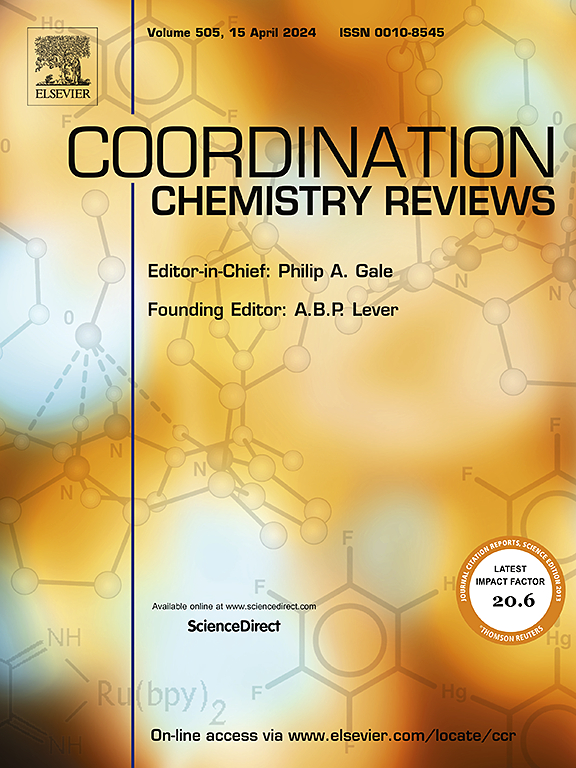Application of metal polyphenol nanonetworks in phototherapy
IF 20.3
1区 化学
Q1 CHEMISTRY, INORGANIC & NUCLEAR
引用次数: 0
Abstract
Phototherapy, characterized as a minimally invasive and highly selective therapeutic modality, encounters significant challenges, primarily due to constraints related to light penetration and treatment specificity. Metal-Phenolic Networks (MPNs), synthesized through dynamic coordination between polyphenols and transition metals, present a versatile platform for phototherapy applications. In contrast to conventional nanomaterials, MPNs offer distinct advantages, including exceptional tunability, facilitating precise modulation of composition, optical characteristics, and therapeutic efficacy. This review specifically emphasizes innovations pertaining to MPNs within the phototherapy domain, examining how they address traditional bottlenecks through biointerface engineering, tailored photophysical properties, multimodal synergy, and phototherapy-guided bioimaging. Furthermore, we analyze the specific applications of MPNs across various phototherapeutic strategies, highlighting recent advancements in photothermal therapy (PTT), photodynamic therapy (PDT), bioimaging, and additional phototherapeutic modalities. Finally, we summarize the prevailing findings and provide a perspective on the future development of MPNs. Unlike other reviews primarily focused on material synthesis and tumor therapy, this comprehensive exploration elucidates the unique value and significant advantages of MPNs within the phototherapy landscape, offering novel insights and avenues for future research and clinical applications.
金属多酚纳米网络在光疗中的应用
光疗作为一种微创和高选择性的治疗方式,面临着巨大的挑战,主要是由于与光穿透和治疗特异性相关的限制。通过多酚类物质与过渡金属之间的动态配位合成的金属-酚网络(mpn)为光疗应用提供了一个多功能平台。与传统纳米材料相比,mpn具有明显的优势,包括卓越的可调性,促进成分、光学特性和治疗效果的精确调制。这篇综述特别强调了光疗领域中与mpn相关的创新,研究了它们如何通过生物界面工程、量身定制的光物理特性、多模态协同和光疗引导的生物成像来解决传统的瓶颈。此外,我们分析了mpn在各种光疗策略中的具体应用,重点介绍了光热疗法(PTT)、光动力疗法(PDT)、生物成像和其他光疗方式的最新进展。最后,我们总结了目前的研究结果,并对mpn的未来发展提出了展望。与其他主要关注材料合成和肿瘤治疗的综述不同,这项全面的探索阐明了mpn在光疗领域的独特价值和显著优势,为未来的研究和临床应用提供了新的见解和途径。
本文章由计算机程序翻译,如有差异,请以英文原文为准。
求助全文
约1分钟内获得全文
求助全文
来源期刊

Coordination Chemistry Reviews
化学-无机化学与核化学
CiteScore
34.30
自引率
5.30%
发文量
457
审稿时长
54 days
期刊介绍:
Coordination Chemistry Reviews offers rapid publication of review articles on current and significant topics in coordination chemistry, encompassing organometallic, supramolecular, theoretical, and bioinorganic chemistry. It also covers catalysis, materials chemistry, and metal-organic frameworks from a coordination chemistry perspective. Reviews summarize recent developments or discuss specific techniques, welcoming contributions from both established and emerging researchers.
The journal releases special issues on timely subjects, including those featuring contributions from specific regions or conferences. Occasional full-length book articles are also featured. Additionally, special volumes cover annual reviews of main group chemistry, transition metal group chemistry, and organometallic chemistry. These comprehensive reviews are vital resources for those engaged in coordination chemistry, further establishing Coordination Chemistry Reviews as a hub for insightful surveys in inorganic and physical inorganic chemistry.
 求助内容:
求助内容: 应助结果提醒方式:
应助结果提醒方式:


